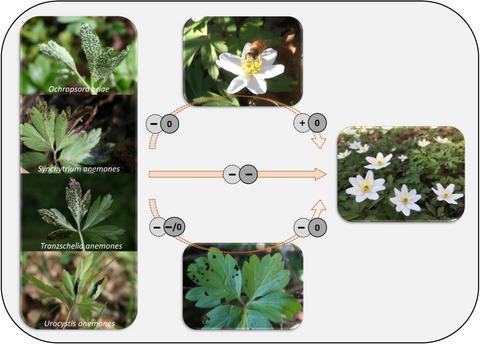Our official English website, www.x-mol.net, welcomes your
feedback! (Note: you will need to create a separate account there.)
Direct and insect-mediated effects of pathogens on plant growth and fitness
Journal of Ecology ( IF 5.3 ) Pub Date : 2021-05-17 , DOI: 10.1111/1365-2745.13689 Laura J.A. van Dijk 1 , Johan Ehrlén 1 , Ayco J.M. Tack 1
中文翻译:

病原体对植物生长和适应性的直接和昆虫介导的影响
更新日期:2021-07-09
Journal of Ecology ( IF 5.3 ) Pub Date : 2021-05-17 , DOI: 10.1111/1365-2745.13689 Laura J.A. van Dijk 1 , Johan Ehrlén 1 , Ayco J.M. Tack 1
Affiliation

|
- Plants are attacked by a large diversity of pathogens. These pathogens can affect plant growth and fitness directly but also indirectly by inducing changes in the host plant that affect interactions with beneficial and antagonistic insects. Yet, we lack insights into the relative importance of direct and indirect effects of pathogens on their host plants, and how these effects differ among pathogen species.
- In this study, we examined four fungal pathogens on the wood anemone Anemone nemorosa. We used field observations to record the impacts of each pathogen species on plant growth and fitness throughout the season, and experimental hand pollination and insect feeding trials to assess whether fitness impacts were mediated by pathogen-induced changes in plant–pollinator and plant–herbivore interactions.
- Three out of four pathogens negatively affected plant size, and pathogens differed strongly in their effect on plant architecture. Infected plants had lower fitness, but this effect was not mediated by pollinators or herbivores. Even so, two out of four pathogens reduced herbivory on anemones in the field, and we found negative effects of pathogen infection on herbivore preference and performance in feeding trials.
- Synthesis. Our results are of broader significance in two main respects. First, we demonstrated that pathogens negatively affected plant growth and fitness, and that the magnitude of these effects varied among pathogen species, suggesting that pathogens constitute important selective agents that differ in strength. Second, direct effects on plant fitness were more important than effects mediated by beneficial and antagonistic insects. In addition, although we did not detect insect-mediated effects on plant fitness, the negative effects of some pathogens on herbivore preference and performance indicate that pathogen communities influence the distribution and abundance of herbivores.
中文翻译:

病原体对植物生长和适应性的直接和昆虫介导的影响
- 植物受到多种病原体的攻击。这些病原体可以直接影响植物的生长和健康,但也可以通过诱导宿主植物的变化来间接影响与有益和拮抗昆虫的相互作用。然而,我们缺乏对病原体对其寄主植物的直接和间接影响的相对重要性的见解,以及这些影响在病原体物种之间有何不同。
- 在这项研究中,我们检查了木海葵Anemone nemorosa上的四种真菌病原体。我们使用实地观察来记录每个病原体物种在整个季节对植物生长和适应性的影响,以及实验性手授粉和昆虫饲养试验来评估适应性影响是否由病原体引起的植物-传粉媒介和植物-食草动物相互作用的变化介导.
- 四分之三的病原体对植物大小产生负面影响,病原体对植物结构的影响差异很大。受感染的植物具有较低的适应性,但这种影响不是由传粉媒介或食草动物介导的。即便如此,四分之二的病原体减少了田间海葵的食草性,我们发现病原体感染对食草动物的偏好和喂养试验的表现有负面影响。
- 合成。我们的结果在两个主要方面具有更广泛的意义。首先,我们证明病原体对植物生长和适应性产生负面影响,并且这些影响的程度因病原体物种而异,这表明病原体构成了强度不同的重要选择剂。其次,对植物适应性的直接影响比有益昆虫和拮抗昆虫介导的影响更重要。此外,虽然我们没有检测到昆虫介导的对植物适应性的影响,但一些病原体对食草动物偏好和表现的负面影响表明病原体群落影响食草动物的分布和丰度。











































 京公网安备 11010802027423号
京公网安备 11010802027423号